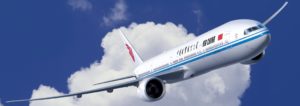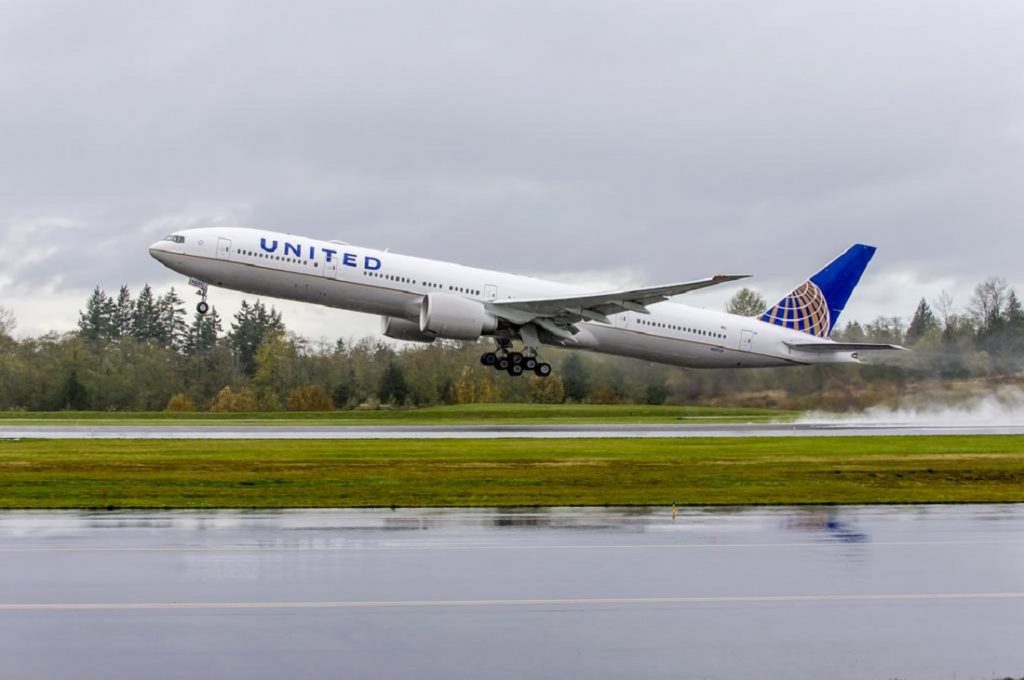Leeham News and Analysis
There's more to real news than a news release.
China will accelerate development of its commercial aerospace sector
Subscription Required
The second of two articles.
By Scott Hamilton
Nov. 21, 2022, © Leeham Co.: Western aerospace companies that invested in China face challenging times ahead in a changing trade environment.

The COMAC C919 is a means to an end in the development of China’s commercial aerospace industry. Credit: Leeham News.
This is especially true for US companies. The overhang of trade and political tensions between the US and China makes for difficult times ahead. European companies are less threatened. Nevertheless, these face uncertainties as China strives to build its own commercial aerospace industry.
This effort “puts western companies that have made capital investments in Chinese capacity in a difficult situation just structurally because they have either JVs or WFOES (Wholly Foreign-Owned Enterprises) or other engagements with Chinese-based industrial assets that will be hard to navigate simply from a trade compliance perspective,” says Michael McAdoo, Partner & Director, Global Trade and Investment for Boston Consulting Group.
“Non-Chinese companies now have a very difficult environment to navigate versus a decade ago. I think there will be a huge push to create the capacity, for engines, for airframes, and for key systems.”
McAdoo The C919 essentially was China going shopping basically for what it considered to be best of breed and all these different technologies. The majority of these come from Western suppliers. Then they were integrated into China with some Chinese design and build structures, but even that structure had some western partners at various places.
Related articles:
Excluding China in Boeing forecast recognizes trade, geopolitical realities
Subscription Required
By Scott Hamilton
Nov. 8, 2022, © Leeham News: Boeing CEO David Calhoun last week said Boeing’s future through at least 2025/2026 doesn’t include assuming China is part of its equations.
It’s a good thing. Relations between the US and China are heading south. The Pentagon last week outlined an extremely pessimistic outlook pointing to future military conflict with China. The Biden Administration not only didn’t reverse tariffs imposed in 2017 by the Trump Administration, but in some respects, Biden upped the game.
Related Article
Boeing started remarketing 737 MAXes ordered by China. It also began taking engines off those airplanes to put onto new production aircraft. Boeing—and others—don’t see China taking any new deliveries from China in the next two or three years or placing orders with Boeing.
Trade publication Airfinance Journal reported Oct. 31 that nearly one in five leased aircraft owned by Chinese lessors are being offered for sale to non-Chinese interests. LNA previously reported that Chinese lessors were being allowed to accept a small number of MAXes providing they were leased outside China.
A trade expert for Boston Consulting Group outlined how he sees relations between China, the US and Europe in an Oct. 26 interview with LNA.
Summary
- China considers the US to be the enemy, one well-placed observer notes.
- The US, EU see China differently.
- Airbus has a window of opportunity.
China still needs Boeing as much as Boeing needs China, despite interminable limbo
Subscription Required
By Scott Hamilton
Oct. 31, 2022, © Leeham News: China needs Boeing as much as Boeing needs China was the conclusion of an analysis by LNA in July 2021. A trade expert last week agreed. Airbus and China’s COMAC won’t be able to fill the future demand forecast for China.
Michael McAdoo, Partner & Director, Global Trade and Investment of the Boston Consulting Group (BCG) in Montreal and a former strategic chief of Bombardier Commercial Aircraft, told LNA in an interview last week that China needs the Boeing 737 MAX and widebody airplanes to meet demand in the near-to-medium term.
It will be long-term before China’s commercial aviation industry will be competitive with airplane designs and production.
Summary
Forecasts for China’s demand for jet aircraft are consistent between Airbus and Boeing. But COMAC, which is the leader of China’s burgeoning commercial aviation industry, is significantly higher in its forecast. The independent Japan Aircraft Development Corp (JADC) is significantly lower.
- Boeing forecasts that China needs 8,485 new jets through 2041.
- Airbus forecasts 8,420 new aircraft will be needed through 2041.
- COMAC forecasts China will need 9,084 aircraft through 2040.
- JADC is more conservative, forecasting a requirement for 6,172 new jets in China through 2041.
China will account for 21% of the world’s new aircraft deliveries through 2041, Boeing says.
UPDATE: Calhoun upbeat on cash flow despite fifth consecutive quarterly loss
By Bryan Corliss
Oct. 26, 2022, (c) Leeham News: The Boeing Co. posted a loss from operations of nearly $2.8 billion for the third quarter, citing losses on fixed-price defense development programs that offset an overall 4% growth in revenues.
 The consensus of Wall Street analysts earlier this week was that Boeing would announce profits of 13 cents a share and would break a streak of four consecutive losing quarters. Instead, Boeing posted a loss of $5.49 a share.
The consensus of Wall Street analysts earlier this week was that Boeing would announce profits of 13 cents a share and would break a streak of four consecutive losing quarters. Instead, Boeing posted a loss of $5.49 a share.
However, in a conference call with stock analysts later in the morning, Calhoun was upbeat, emphasizing Boeing’s positive operating cash flow of nearly $3.2 billion for the quarter.
“This quarter was a big one for us,” he said. “We hit a marker … to generate positive cash flow.”
Boeing booked losses of roughly $1.95 billion on two defense programs, CFO Brian West said: KC-46 tankers and new Air Force One presidential transports. Both are fixed-price contracts for commercial jet conversions that forced Boeing to eat any cost overruns.
“We aren’t embarrassed by them,” Calhoun said. “They are what they are.”
But in an interview with CNBC’s Phillip LeBeau Wednesday, Calhoun said Boeing will not do fixed-price defense contracts in the future. “That is not our intent.”
Summary:
- BCA: 737 and 787 deliveries resume; engines in short supply
BDS: ‘Labor instability’ hurts key programs
Calhoun: Boeing ‘supports China’ but is re-marketing planes
Read more
Pontifications: Some customers face 3 month delays in current 737 MAX delivery stream
Sept. 5, 2022, © Leeham News: Boeing has been delivering 737s from its stored inventory and its new production line more slowly than desired. Some customers face a three-month delay, even as Boeing tries to return to normalcy following the 21-month grounding of the MAX and the impact of the two-year pandemic.
The supply chain is a key culprit. Reconfiguring stored airplanes for lessees or buys after a change from the original operator is another. Engine shortages are still another.
BOC Aviation, a lessor headquartered in Singapore, faces three months delays, Robert Martin, the CEO, said in an interview with LNA.
Can China pass on Boeing airplanes? A deeper look
Subscription Required
By Vincent Valery
Introduction
Aug. 8, 2022, © Leeham News: The FAA lifted the Boeing 737 MAX grounding more than 18 months ago. However, Chinese airlines still have not returned their 737 MAX fleets to passenger service.
Chinese airlines have also not taken delivery of any 737 MAX since March 2019. Separately, a Boeing 777-300ER for China Southern Airlines has now been pending delivery for more than two years. While Airbus announced a large A320neo order from Chinese airlines on July 1, no similar order materialized for the 737 MAX at the Farnborough Air Show.
The above raises the question of whether China intends to place new commercial aircraft orders with Boeing. Last year, LNA concluded that China could not rely exclusively on Airbus and COMAC to meet its aircraft requirements.
This article revisits whether Chinese airlines can do without Boeing for single-aisle and twin-aisle aircraft. Airbus announced its intention to increase A320 family production to 75 per month by 2025. The analysis incorporates replacement needs but also looks at different growth assumptions to see whether output by non-Boeing OEMs can accommodate the fleet requirements of the Chinese market.
Summary
- Current China passenger fleet profile;
- Fleet replacement and growth rate assumptions;
- Estimating maximum possible production rates for China without Boeing;
- China needs Boeing airplanes in most scenarios.
China Eastern 737 crashes-it is not a MAX
By Scott Hamilton
March 21, 2022, © Leeham News: A China Eastern Airlines Boeing 737-800 (Flight number MYU5735) crashed today while enroute to Guangzhou. All 132 people on board were killed.
For those likely to jump the gun, it is important to note that this 737 was a Next Generation model, not the MAX. The accident airplane was delivered new to the airline in 2015.

A screenshot of a Chinese CCTV video believed to show China Eastern MU5735 moments before crashing near Guangzhou.
According to flight tracking radar images, the flight was at cruising altitude when it nosed over into a vertical dive. A photo circulating on Twitter shows the airplane in a vertical position moments before the crash.
No conclusions may be drawn about the cause of the crash based on the sketchy information available. As a matter of routine investigative procedures, the following will be areas of inquiry, in no particular order:
Pontifications: From the aviation perspective, there’s something in China to watch
March 21, 2022, © Leeham News: Eyes are focused on Ukraine and the Russian War. In our corner of the world, commercial aviation, the stakeholders follow the fallout from the war: sanctions placed on Russia which affect overflights, supply chains, oil to Europe (fuel), and Russia’s confiscation of about $10bn worth of airliners from Western lessors and lenders.
But there is another drama playing out on the other side of the world, too. This one involves China and one of its commercial aviation companies, AVIC.
AVIC is a major aerospace company in China. It also has a variety of none-aerospace companies. It’s one of these that caught our eye last week.
The Wall Street Journal on March 14 reported that AVIC subsidiaries involved in solar energy filed for bankruptcy to avoid an $85m judgment after allegedly absconding with intellectual property from two US companies. The firm had to settle for 30 cents on the dollar.
It’s another example of China companies simply ignoring international IP laws.
2022 Forecast: C919 EIS unlikely before 2023-24
Subscription Required
By Scott Hamilton
Introduction
Jan. 17, 2022, © Leeham News: COMAC, the Chinese aerospace company developing the C919, suffered yet another setback last year.
It hoped to deliver the first aircraft, designed to compete with the Airbus A320 and Boeing 737-800/8, to China Eastern Airlines by year end. Not only didn’t this delivery take place, but the program is also only about 15% through the certification flight testing.
At this rate, certification, and delivery this year is questionable. LNA’s forecast for EIS is in 2023 or 2024.
COMAC’s other airplane, the regional jet ARJ21, landed its first order outside China (other than from lessor GECAS years ago).
Summary
- C919 is overweight, shortening range, and adversely affecting fuel economy.
- Commercial success of the C919 won’t be possible.
- ARJ21 lands first foreign operator, but it’s not an arm’s length deal.
With high cargo prices, will airlines fly larger aircraft in their widebody fleets?
Subscription Required
By Bjorn Fehrm
Introduction
October 14, 2021, © Leeham News: Over the last weeks, we’ve seen that the present cargo crunch and high yields will influence what aircraft variants airlines purchase. Models that are too large passenger-wise for years to come will be paid for by a longer belly that can take more cargo.
This trend will remain as long as cargo prices are high. Will the high cargo yields also affect what aircraft to keep stored and which to fly of an existing fleet? We apply the analysis to an airline with a fleet of Boeing 777s.
Summary
- The increased yields for air cargo changes the fleet planning for the widebody fleet. The most suitable passenger models stay in the desert, and the longer siblings fly despite lower load factors.








